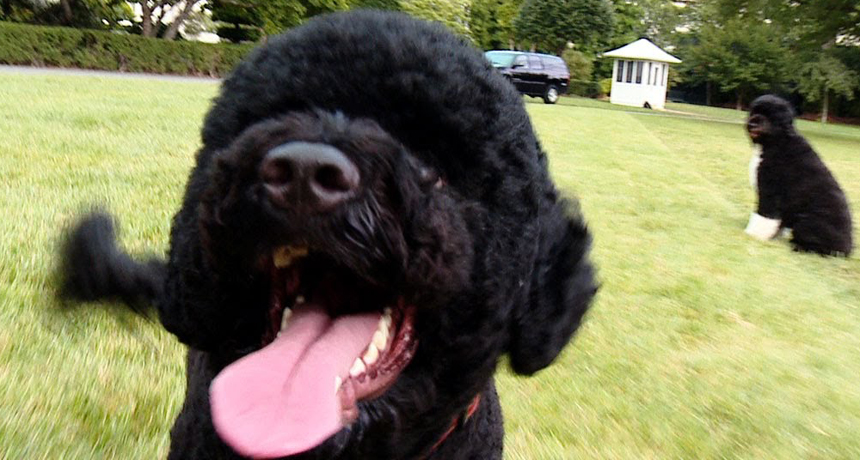Doggy dust could be a good thing
Dust from homes with a pooch appears to limit the risk of allergy — at least in mice

A family dog may lead to fewer allergies in babies, a new study suggests. Shown here are Sunny and Bo, canines that live in the Obama White House.
Pete Souza/whitehouse.gov
Dogs are loyal protectors of a home. The dust these pets drag inside also appears protective, a new study in mice finds. It suggests babies raised alongside dogs develop fewer allergies and infections.
A mix of microbes, or germs (many of them harmless), infests house dust, the scientists note. Homes with dogs harbored dust with a broader mix of microbes than did homes with no pooch, their new data show. And that mix in homes with dogs appears to offer big health benefits, the scientists reported December 16 in the Proceedings of the National Academy of Sciences.
The catalog of all the different types of microbes in one place (be it a stomach, a pond or a garden) is called a microbiome (MY kro BY ohm). The study scientists “saw a profound change in the microbiome” of the guts of mice that had eaten dust from homes with dogs, Nicholas Lukacs told Science News. He worked on the study at the University of Michigan Medical School in Ann Arbor.
The idea that being overly clean can backfire on health is not new. Earlier studies have shown that children exposed to dirt and germs early in life tend to face a lower risk of asthma and allergy as they get older. Growing up with siblings and pets, for example, may strengthen a child’s immune system. This system is made of a collection of cells that defends the body against disease. But it can overreact to ordinary substances like grass or pollen, causing allergy or asthma.
As babies crawl and put things in their mouths, they will eat some dust. So, in the new tests, scientists fed dust to six- to eight-week-old mice. Half of the mice got dust from homes with dogs. The rest of the mice ingested dust from homes without a pooch. Later, the scientists exposed all of the mice to cockroach allergens. These substances — from the insects’ saliva, body or feces — often trigger an allergic reaction in people.
Cockroach allergens provoked the worst reactions in mice that had eaten dust from dog-free homes. Their airways swelled, making it difficult for the mice to breathe. They also produced more mucus than normal, which can be a sign of an allergic reaction.
The cockroach allergens had almost no effects on mice that had eaten dust from homes with dogs. And compared with the other group, these mice also were able to better fight off a serious viral infection. Scientists had exposed the animals to respiratory syncytial (Sin SIH shul) virus. Known as RSV, it is the leading cause of pneumonia among U.S. children less than a year old. RSV tends to trigger less severe disease in older kids.
Ian Mitchell is encouraged by the findings. A pediatrician at the University of Calgary in Canada, he did not work on the new study. But he does worry about RSV in his youngest patients. He says the new mouse study offers “a glimmer of hope” that doctors might be able to delay RSV infection.
Power Words
allergen A substance that causes an allergic reaction.
allergy The inappropriate reaction by the body’s immune system to a normally harmless substance. Untreated, a particularly severe reaction can lead to death.
asthma A disease affecting the body’s airways, which are the tubes through which animals breathe. Asthma obstructs these airways through swelling, the production of too much mucus or a tightening of the tubes. As a result, the body can expand to breathe in air, but loses the ability to exhale appropriately. The most common cause of asthma is an allergy. It is a leading cause of hospitalization and the top chronic disease responsible for kids missing school.
bacterium (plural bacteria) A single-celled organism forming one of the three domains of life. These dwell nearly everywhere on Earth, from the bottom of the sea to inside animals.
germ Any one-celled microorganism, such as a bacterium, fungal species or virus particle. Some germs cause disease. Others can promote the health of higher-order organisms, including birds and mammals. The health effects of most germs, however, remain unknown.
immune system The collection of cells and their responses that help the body fight off infection.
microbe Short for microorganism. (see microorganism)
microorganism (also called a microbe) A living thing that is too small to see with the unaided eye, including bacteria, some fungi and many other organisms such as amoebas. Most consist of a single cell.
pneumonia A lung disease in which infection by a virus or bacterium causes inflammation and tissue damage. Sometimes the lungs fill with fluid or mucus. Symptoms include fever, chills, cough and trouble breathing.
virus Tiny infectious agents consisting of RNA or DNA surrounded by protein. Viruses can reproduce only by injecting their genetic material into the cells of living creatures. Although scientists frequently refer to viruses as live or dead, in fact no virus is truly alive. It doesn’t eat like animals do, or make its own food the way plants do. It must hijack the cellular machinery of a living cell in order to survive.







